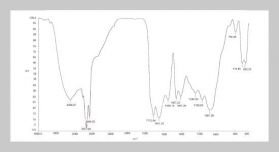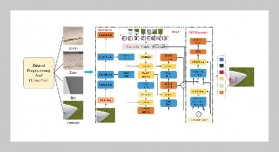Xiaojuan Lu1, Ping Sun 1, and Duojin Fan2
1School of Automation Electrical Engineering of Lanzhou Jiaotong University Lanzhou, 730070, P.R. China
2Lanzhou Dacheng Technology Co. LTD Lanzhou, 730070, P.R. China
Received:
April 11, 2022
Accepted:
June 19, 2022
Publication Date:
February 21, 2023
Copyright The Author(s). This is an open access article distributed under the terms of the Creative Commons Attribution License (CC BY 4.0), which permits unrestricted use, distribution, and reproduction in any medium, provided the original author and source are cited.
Download Citation: ||https://doi.org/10.6180/jase.202310_26(10).0013
ABSTRACT
Aiming at the randomness and strong disturbance of linear Fresnel solar thermal power generation system, a sliding mode predictive control strategy is proposed. First, the dynamic mathematical model of the collector circuit is established by considering solar radiation, molten salt inlet temperature, and ambient temperature.Second, a sliding mode predictive controller for the molten salt outlet temperature of the collector field is developed, the sliding mode prediction control (SMPC) is used because it has the advantages of strong robustness and insensitive disturbances, and solves the problem of the randomness and disturbance of the collector system. At last, we use the data that Dunhuang Dacheng linear Fresnel molten salt photothermal power station has been grid connected operation to simulation test. The results reveal that, when compared to MPC and SMC, SMPC has a faster tracking speed and response time, and lower tracking error for the collector system, as well as improved the collector system’s robustness and anti-interference. Due to the strong wind in Northwest China, it has a significant impact on the collector field. In the future, wind speed should be considered as a disturbance to control the outlet temperature of molten salt in the heat collection field more accurately.
Keywords:
Collector system; Linear Fresnel; Sliding mode predictive control; Solar thermal power generation
REFERENCES
- [1] E. F. Camacho and M. Berenguel, (2012) “Control of solar energy systems" IFAC proceedings volumes 45(15): 848–855. DOI: 10.3182/20120710-4-SG-2026.00181.
- [2] A. W. Jeevadason and S. Padmini, (2022) “Experimental investigation of a passive type solar still with double wedge shape glass cover" Materials Today: Proceedings 56: 308–313. DOI: 10.1016/j.matpr.2022.01.167.
- [3] A. W. Jeevadason, S. Padmini, C. Bharatiraja, et al., (2022) “A review on diverse combinations and Energy-Exergy-Economics (3E) of hybrid solar still desalination" Desalination 527: 115587. DOI: 10.1016/j.desal.2022.115587.
- [4] A. W. Jeevadason, S. Padmini, and C. Bharatiraja, (2022) “Enhancing Freshwater Productivity of Twin Wedge Solar Still by Temperature Control Through Thermoelectric Sensors and Modules" IEEE Sensors Journal 22(9): 9095–9103. DOI: 10.1109/JSEN.2022.3162311.
- [5] W. J. Aruldoss, S. Padmini, and C. Bharatiraja, (2022) “Experimental investigation of a novel design solar still desalination system" ECS Transactions 107(1): 18789.DOI: 10.1149/10701.18789ecst/meta.
- [6] M. Yang, Y. Zhu, and R. A. Taylor, (2018) “End losses minimization of linear Fresnel reflectors with a simple, two-axis mechanical tracking system" Energy conversion and management 161: 284–293. DOI: 10.1016/j.enconman.2018.01.082.
- [7] D. M. Lima, J. E. Normey-Rico, and T. L. M. Santos, (2016) “Temperature control in a solar collector field using filtered dynamic matrix control" ISA transactions 62:39–49. DOI: 10.1016/j.isatra.2015.09.016.
- [8] M. Karamali and M. Khodabandeh, (2017) “A distributed solar collector field temperature profile control and estimation using inlet oil temperature and radiation estimates based on iterative extended kalman filter" Renewable energy 101: 144–155. DOI: 10.1016/j.renene.2016.08.049.
- [9] S. J. Navas, F. R. Rubio, P. Ollero, and J. M. Lemos, (2018) “Optimal control applied to distributed solar collector fields with partial radiation" Solar Energy 159: 811–819. DOI: 10.1016/j.solener.2017.11.052.
- [10] P. Gil, J. Henriques, A. Cardoso, P. Carvalho, and A. Dourado, (2013) “Affine neural network-based predictive control applied to a distributed solar collector field" IEEE Transactions on control systems technology 22(2): 585–596. DOI: 10.1109/TCST.2013.2260545.
- [11] J. Len, J. Fernandez, M. Berenguel, et al., (2019) “Adaptive UKF-based model predictive control of a Fresnel collector field [J]" Journal of Process Control 85: 76–90. DOI: 10.1016/j.jprocont.2019.09.003.
- [12] T. de Araújo Elias, P. R. Costa Mendes, and J. Elias Normey-Rico, (2019) “Mixed logical dynamical nonlinear model predictive controller for large-scale solar fields" Asian Journal of Control 21(4): 1881–1891. DOI: 10.1002/asjc.1967.
- [13] X. Lu and Z. Liang, (2021) “Application of model predictive control based on kalman filter in solar collector field of solar thermal power generation" Energy Engineering: Journal of the Association of Energy Engineering 118(4): 1171–1183. DOI: 10.32604/EE.2021.014724.
- [14] A. Feyo, A. R. Thelkar, C. Bharatiraja, and A. Yusuff, (2020) “Reference design and comparative analysis of model reference adaptive control for steam turbine speed control" FME Transactions 48: 329–341. DOI: 10.5937/fme2002329F.
- [15] V. Jayakumar, B. Chokkalingam, and J. L. Munda, (2021) “A comprehensive review on space vector modulation techniques for neutral point clamped multi-level inverters" IEEE Access 9: 112104–112144. DOI: 10.1109/ACCESS.2021.3100346.
- [16] V. Jayakumar and C. Bharatiraja, (2022) “Model Predictive Control of PMSM Motor Drive for Electric Vehicle Applications with Space Vector Modulation" ECS Transactions 107(1): 14465. DOI: 10.1149/10701.14465ecst/meta.
- [17] L. X. and D. H., (2015) “Predictive control of nonlinear model for heat collecting system with terminal limit in solar thermal power generation system" Thermal Power Generation 10: 63–64.
- [18] G. Pin, M. Falchetta, and G. Fenu, (2008) “Adaptive time-warped control of molten salt distributed collector solar fields" Control Engineering Practice 16(7): 813–823. DOI: 10.1016/j.conengprac.2007.08.008.
- [19] A. J. Gallego and E. F. Camacho, (2012) “Adaptative state-space model predictive control of a parabolic-trough field" Control Engineering Practice 20(9): 904–911. DOI: 10.1016/j.conengprac.2012.05.010.
- [20] X. Zhang, L. Wen-Ru, L. Zhang, and W.-B. Xu, (2020) “Application of fractional calculus in iterative sliding mode synchronization control" Archives of Electrical Engineering 69(3):
- [21] H. Zhang, H. Dong, B. Zhang, T. Wu, and C. Chen, (2020) “Research on beam supply control strategy based on sliding mode control" Archives of Electrical Engineering69(2): DOI: 10.24425/aee.2020.133030.
- [22] H. Caballero-Barragán, L. P. Osuna-Ibarra, A. G. Loukianov, and F. Plestan, (2018) “Sliding mode predictive control of linear uncertain systems with delays" Automatica 94: 409–415. DOI: 10.1016/j.automatica.2018.04.040.
- [23] G. Andrade, D. Pagano, J. D. Alvarez, and M. Berenguel, (2013) “A practical NMPC with robustness of stability applied to distributed solar power plants" Solar Energy 92: 106–122. DOI: 10.1016/j.solener.2013.02.013.
- [24] R. Carmona, (1985) “Analysis, modeling and control of a distributed solar collector field with a one-axis tracking system [PhD Thesis]" Spain (in Spanish): University of Seville:
- [25] T. de Araújo Elias, P. R. da Costa Mendes, and J. E. Normey-Rico, (2019) “Hybrid predictive controller for overheating prevention of solar collectors" Renewable Energy 136: 535–547.
















